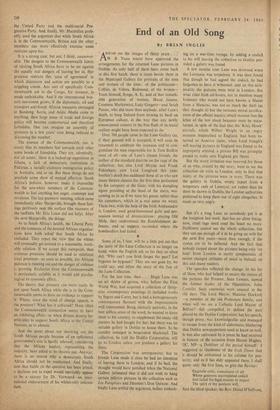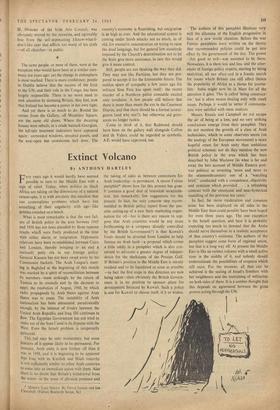End of an Old Song
By BRIAN INGLIS
`ROUND ROUND me the images of thirty years . .
A
B. Yeats would have approved the arrangements for the returned Lane pictures in Dublin. As only half of them have come back in this first batch, there is room beside them in the Municipal Gallery for portraits of the men and women of the time: of the politicians— Collins, de Valera, Redmond; of the writers— Yeats himself, Synge, A. E.; and of that remark- able generation of women, Maud Gonne, Countess Markiewicz, Lady Gregory—and Sarah Purser, who did more than anybody, after Lane's death, to keep Ireland from turning its back on European culture, in the way that any newly emancipated country in the first flush of its social realism might have been expected to do.
Over 700 people came to the Lane Gallery (as, if their general will is accepted, it will soon be renamed) to celebrate the occasion and to con- gratulate the men responsible for it. Tom Bodkin most of all—one of Lane's closest friends, the author of the standard diatribe on the rape of the collection; but also Lord Moyne and Frank Pakenham, now Lord Longford (his elder brother's death has saddened those of us who saw many theatre classics for the first time performed by his company at the Gate; with his dumpling figure presiding at the head of the stairs, wel- coming us in as if we were his guests rather than his customers, which in a real sense we were). These two, with the help of the Irish Ambassador in London, used good-humoured guile and per- suasion instead of denunciations: playing Old Mole, they undermined the Establishment de- fences; and as sappers succeeded where the bombardiers had failed.
*
Some of us, I fear, will be a little put out that the story of the Lane Collection is no longer on hand, when the English ask us (as they so often do), `Why can't you Irish forget the past? Let bygones be bygones?' They are not gone by, we could say; and relate the story of the fate of the Lane Collection.
For the last time, then . . . Hugh Lane was an art dealer of genius, who, before the First World War, had acquired a collection of thirty- nine contemporary paintings (it included works by Ingres and Corot, but it had a homogeneously contemporary flavour) with the Impressionists well represented. Being intensely patriotic, in the best selfless sense of the word, he wanted to leave them to his country, to supplement the many old masters he had bought for her; but there- was no suitable gallery in Dublin to house them. So he sensibly indulged in benevolent blackmail. The collection, he told the Dublin Corporation, will go to London unless you produce a gallery for them.
The Corporation was unresponsive; but to friends Lane made it clear he had no intention of leaving them to London; and if he had, the thought would have perished when the-National Gallery intimated that it did not wish to hang certain inferior pictures in the collection such as Les Parapluies and Daumier's Don Quixote. And finally Lane settled the argument, before embark- ing on a war-time voyage, by adding a codicil in his will leaving the collection to Dublin pro- vided a gallery was found.
A few months later Lane was drowned when the Lusitania was torpedoed. It was then found that though he had signed the codicil, he had forgotten to have it witnessed; and on this tech- nicality the pictures were held in London. But what riled Irish art-lovers, not to mention many Irishmen who would not have known a Manet from a Mancini, was not so much the theft (as they thought it) but the tortuous moral justifica- tions of the official inquiry, which insisted that the letter of the law about bequests must be main- tained, in spite of the fact that the 'Kitty Hawk' aircraft, which Wilbur Wright in an angry moment bequeathed to England, had been re- turned to America (later, when Lord Iveagh's will leaving pictures to England was found to be improperly attested, a private Bill was promptly passed to make sure England got them).
But the worst irritation was reserved for those of us who, roused by the story, went to see the collection on visits to London; only to find that many of the pictures were in store. There was the gallery in Dublin, empty (apart from a temporary rash of Laverys); yet rather than let them be shown in Dublin, the London authorities preferred to keep them out of sight altogether. It made us very angry.
But it's a long Lane, as somebody put it at the reception last week, that has no silver lining; now, cruel rage need rend the heart no more. Dubliners cannot see the whole collection, but they can see enough of it to be going on with for the next five years—more than enough, if the cynics are to be believed. And the fact that nobody carped about the pictures being only 'on loan' fron) London is surely symptomatic, of recent changed attitudes of mind in Ireland, on this and many matters.
The speeches reflected the change. In his list of those who had helped to secure the return of the pictures the Premier, Sean Lemass, named the former leader of the Opposition, John Costello. Such courtesies were unusual in the old days. The Lord Mayor, Maurice Dockrell —a member of the old Protestant family; and when will we see a Catholic Lord Mayor of Belfast?—felt compelled to defend the part played by the Dublin Corporation; but his speech, though prosy, was knowledgeable and managed to escape from the kind of aldermanic blathering that Dublin newspapermen used to know so well. It was also enlivened by a poem he had received in honour of the occasion from Hector Hughes, QC, MP—a Dubliner of the period himself: I suggested to Quidnunc of the Irish Times that it should be embalmed in his column for pos- terity, and as it has duly appeared there, I shall quote only the first lines, to give.the flavour:
Exquisite critic, connoisseur of art Whose generous uncompleted codicil Just failed for legal reasons to impart The spirit of thy patriotic will.
And the third speaker, the Rev. Donal O'Sullivan, SJ, Director of the Irish Arts Council, was obviously moved by the occasion, and agreeably free from the self-deprecating 1-know-what-I- don't-like cant that afflicts to many of his cloth —of all churches—in public.
The same people, or most of them, were at the reception who would have been at a similar cere- mony ten years ago; yet the change in atmosphere is most marked. There is more confidence; people in Dublin believe that the success of the Irish at the UN, and their role in the Congo, has been largely responsible. There is no more need to seek attention by damning Britain. they feel, now that Ireland has become a power in her own right.
And yet there is so much to do. Round the corner from the Gallery, off Mountjoy Square, are the same old slums. Where the decaying houses were rebuilt, in a crude barrack-Georgian, the tell-tale tenement indicators have appeared again: unmended windows, smashed panels, and the ever-open but unwelcome hall door. The country's economy is flourishing, but emigration is as high as ever. And the educational system is coming under harsh attacks not so much, as of old, for excessive concentration on trying to raise the dead language, but for general low standards imposed by the Church's determination not to let the State give more assistance, in case this would give it more control.
Still, people are not thinking the way they did. They may not like Partition, but they are pre- pared to accept it for the foreseeable future. The sudden spurt of sympathy a few years ago for militant Sinn Fein has spent itself : the recent murder of a Northern police constable excited only revulsion. A few people still believe that there is more than meets the eye in the Casement Diaries, and that there should be a formal investi- gation (and why not?); but otherwise old griev- ances no longer rankle.
Come to think of it, that Redmond should have been on the gallery wall alongside Collins and de Valera could be regarded as symbolic. A.E. would have approved, too.







































 Previous page
Previous page